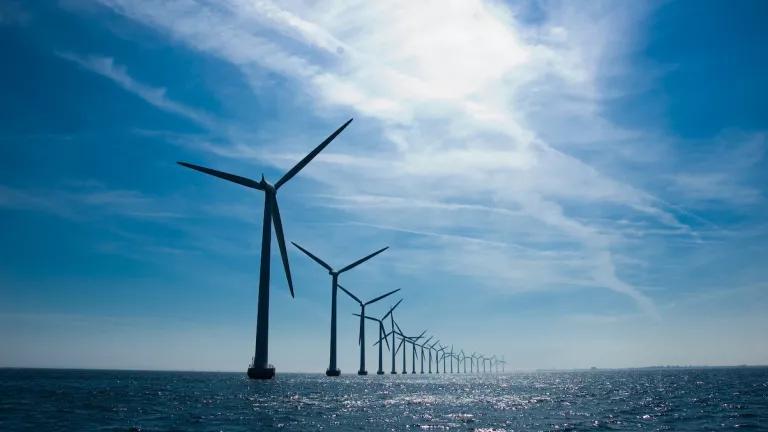Wind Is Reliable. It’s Time for New England to Plan for More of It
As the electricity system becomes cleaner, it is critical that ISO New England properly values the reliability of offshore wind.
New England’s electricity system is rapidly evolving. Thanks to proactive state climate policies and market forces, cheap renewable power is replacing fossil fuels. As the system changes, it is critical that grid operators like ISO New England—which maintains reliability for six New England states by ensuring there is enough power to keep the lights on—accurately evaluates the benefits that renewable resources provide in order to properly value their contribution to the system. Renewable energy like offshore wind can provide crucial reliability benefits to the region, especially during extreme weather events when this energy is most needed.
ISO New England recently published a study examining the impacts of extreme weather—which will become more severe and frequent because of climate change—on the electricity system. One notable result was the performance of wind. The ISO’s model recognizes the correlation between wind output and extreme weather events, which are often characterized by high wind speeds. This means that wind is providing power when the system is the most in need, keeping the lights on during the worst winter storms.
Wind did better than expected during a recent winter storm
A good example of this is wind performance during a recent winter storm. ISO New England forecasts wind output using a model to predict wind speeds. Wind speeds vary, and wind is not always able to perform at its maximum capacity. But high-capacity offshore wind can provide power at crucial moments when the system is the most stressed. During a mid-January 2024 cold snap, even sophisticated modeling tools underpredicted how well wind would perform. As shown in the chart below, wind output was higher than expected 77% of the time during the storm.

Graph showing actual wind output January 15-21 compared to the seven-day ISO-NE forecast for wind performance.
Sources: Grid Status (https://www.gridstatus.io/graph/renewables?iso=isone&date=2024-01-15to2024-01-21), ISO-NE Seven-Day Wind Power Forecast (https://www.iso-ne.com/isoexpress/web/reports/operations/-/tree/seven-day-wind-power-forecast). Data accessed 2/7/2024.
This better-than-expected performance shows that wind shows up during periods that are most important for system reliability. Luckily, the ISO’s extreme weather study more accurately models wind’s real performance, showing that it is correlated with temperature and weather. Using models like this to plan for the future is a step in the right direction.
More wind = cheaper power
Unfortunately, the region still relies to a large extent on gas for electricity and heating. This is a problem for customers’ pocketbooks and for keeping the lights on. During the winter storm in mid-January, real time power and gas prices in New England were at their highest in a year. Because New England relies on gas for 52% of its electricity generation (much higher than the national average of 40%) as well as for home heating, volatile gas prices are passed directly to consumers’ electricity and gas bills. Unlike other regions, New England faces a physical constraint: there is not enough pipeline capacity to adequately supply the region during extreme weather events. To make matters worse, gas plants often fail during storms, when the region needs them the most. Due to this constraint, prices can skyrocket when demand for electricity and gas rises, leading to high bills. Unlike fossil fuels, the fuel costs for wind are zero. Thus, during periods when the gas and electric system are stressed, wind provides a cheap and reliable form of energy, reducing costs to consumers.
New England must increase the pace of renewable energy deployment
According to a 2019 Brattle study, “if New England wants to make good on their greenhouse gas emissions reduction goals, they will need to keep their foot on the clean electricity development.”
This means that projects need to get through the interconnection queue faster. As of February 2024, there are over 41 gigawatts (GW) of solar, on- and off-shore wind, battery storage, and hybrid resources in the queue. Projects currently take an average of 3 to 9 years to connect to the grid.

Proposed renewable and battery storage projects in the ISO-NE generation interconnection queue.
When it comes to offshore wind deployment, this also means thinking beyond a project-by-project approach and designing a system that can cost effectively deliver this clean power regionally and interregionally. Several Northeast states have taken steps in this direction—Massachusetts, Connecticut and Rhode Island have entered into an agreement to solicit regional offshore wind projects that will provide benefits to all three states while reducing costs to ratepayers. Additionally, states in the Northeast, along with New Jersey and New York, have formed the Northeast States Collaborative on Interregional Transmission to explore opportunities for increasing connections, including offshore wind, between ISO-NE, NYISO, and PJM. Building more transmission between regions would lower electricity prices, increase reliability during periods of extreme weather and high demand, and help states achieve their clean energy goals. ISO-NE can and should provide technical support for the Collaborative and look for additional ways to increase connections between it and other regions.
Additionally, the ISO should consider the reliability benefit of wind—and the operational constraints of gas—during its ongoing Resource Capacity Accreditation process. To put it simply, all resources should be valued for their contribution to the system when it is under the most stress. In the ISO’s current proposal, though, offshore wind will be undervalued, and gas will be overvalued. This is because the ISO proposed to value onshore and offshore wind the same way, without acknowledging that offshore wind will have higher capacity factors than onshore wind. Similarly, the ISO is planning to value gas without looking at its real performance and outages during storms. The ISO needs to be honest about the un-reliability of gas in its accreditation process.
Investing in offshore wind and properly valuing gas un-reliability isn't just about embracing a greener future; it's a practical and cost-effective solution that ensures New England maintains reliability, benefiting the economy while keeping the lights on. ISO New England can usher in the clean energy future. There is no time to waste.





